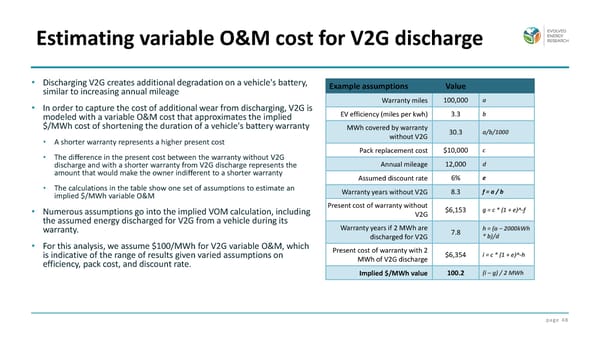page 48 • Discharging V2G creates additional degradation on a vehicle's battery, similar to increasing annual mileage • In order to capture the cost of additional wear from discharging, V2G is modeled with a variable O&M cost that approximates the implied $/MWh cost of shortening the duration of a vehicle's battery warranty • A shorter warranty represents a higher present cost • The difference in the present cost between the warranty without V2G discharge and with a shorter warranty from V2G discharge represents the amount that would make the owner indifferent to a shorter warranty • The calculations in the table show one set of assumptions to estimate an implied $/MWh variable O&M • Numerous assumptions go into the implied VOM calculation, including the assumed energy discharged for V2G from a vehicle during its warranty. • For this analysis, we assume $100/MWh for V2G variable O&M, which is indicative of the range of results given varied assumptions on efficiency, pack cost, and discount rate. Estimating variable O&M cost for V2G discharge Example assumptions Value Warranty miles 100,000 a EV efficiency (miles per kwh) 3.3 b MWh covered by warranty without V2G 30.3 a/b/1000 Pack replacement cost $10,000 c Annual mileage 12,000 d Assumed discount rate 6% e Warranty years without V2G 8.3 f = a / b Present cost of warranty without V2G $6,153 g = c * (1 + e)^-f Warranty years if 2 MWh are discharged for V2G 7.8 h = (a – 2000kWh * b)/d Present cost of warranty with 2 MWh of V2G discharge $6,354 i = c * (1 + e)^-h Implied $/MWh value 100.2 (i – g) / 2 MWh
 Exploring the Value of Vehicle to Grid (V2G) for California Page 47 Page 49
Exploring the Value of Vehicle to Grid (V2G) for California Page 47 Page 49